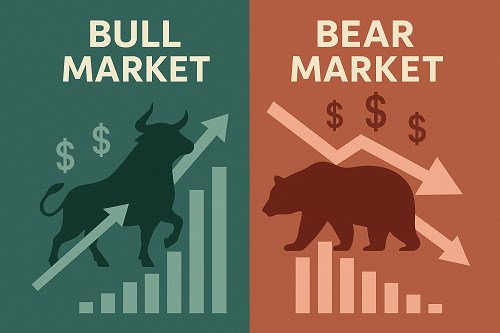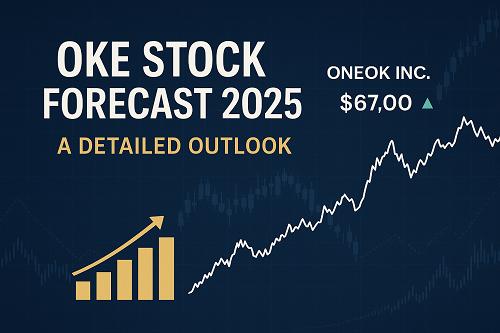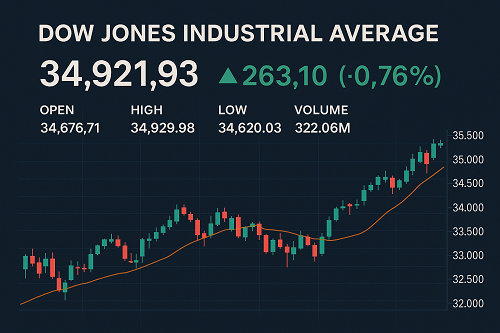Every trader and investor eventually learns that markets move in cycles — waves of optimism and fear that define the very essence of finance.
These opposing forces are embodied by two timeless symbols: the bull, charging upward with confidence, and the bear, swiping downward in retreat.
Whether you trade stocks, forex, or crypto, understanding bull and bear markets is essential. These cycles influence not only prices but also investor psychology, capital flow, and strategy selection.
This guide explores how to identify, trade, and thrive in both environments — with real-world data, actionable tips, and professional insights for 2025 and beyond.
What Is a Bull Market?
A bull market refers to a sustained period of rising asset prices — typically 20% or more above recent lows.
Optimism, high investor confidence, and strong economic indicators define these times.
Key Characteristics of a Bull Market
| Indicator | Description |
|---|---|
| Price Trend | Upward, with higher highs and higher lows |
| Investor Sentiment | Optimistic; “buy the dip” mentality |
| Trading Volume | Increasing as more participants join |
| Economic Conditions | Expanding GDP, low unemployment, stable inflation |
| Monetary Policy | Often accommodative (low interest rates) |
Historical Examples
- S&P 500 (2009–2020): The longest bull run in modern history, driven by tech growth and QE policies.
- Bitcoin (2020–2021): Crypto’s explosive rise from $8,000 to over $60,000 showcased a textbook bull pattern.
- USD/JPY (2012–2015): A forex bull driven by Abenomics and U.S. rate optimism.
What Is a Bear Market?
A bear market occurs when prices fall 20% or more from recent highs, often accompanied by fear, selling pressure, and pessimism.
Key Characteristics of a Bear Market
| Indicator | Description |
|---|---|
| Price Trend | Downward, with lower highs and lower lows |
| Investor Sentiment | Fearful; “cash is king” mindset |
| Trading Volume | Volatile; spikes on panic selling |
| Economic Conditions | Contracting GDP, layoffs, inflation risk |
| Monetary Policy | Tightening or uncertain |
Historical Examples
- Dot-com Crash (2000–2002): Tech valuations collapsed, wiping out trillions in equity value.
- Global Financial Crisis (2008–2009): Housing collapse led to one of the worst bear markets in history.
- Crypto Winter (2022–2023): Bitcoin and altcoins fell over 70%, marking a severe bearish correction.
The Psychology Behind Bulls and Bears
Markets are not only economic systems — they’re psychological ecosystems.
In bull phases, greed and FOMO dominate; in bear phases, fear and regret take over.
The Emotional Cycle of Market Participants
- Optimism → Euphoria → Complacency (Bull Market Peak)
- Anxiety → Fear → Capitulation → Despair (Bear Market Bottom)
- Hope → Relief → Optimism (Recovery and New Bull Run)
Behavioral Traps
| Trap | Description | Market Phase |
|---|---|---|
| Overconfidence Bias | Traders take excessive risk | Late bull |
| Loss Aversion | Investors refuse to sell losing positions | Early bear |
| Recency Bias | Assuming recent trends will continue | Both |
How to Identify Bull and Bear Markets Early
Smart traders rely on technical, fundamental, and macro signals to anticipate transitions.
Technical Indicators
| Indicator | Bullish Signal | Bearish Signal |
|---|---|---|
| Moving Averages (MA) | 50-day MA above 200-day MA | 50-day MA below 200-day MA |
| RSI (Relative Strength Index) | Above 50 (momentum up) | Below 50 (momentum down) |
| Market Breadth | Expanding | Contracting |
| VIX (Volatility Index) | Falling (confidence) | Rising (fear) |
Fundamental & Macro Clues
- Bullish: Rising earnings, low inflation, strong GDP growth
- Bearish: Earnings contraction, rate hikes, consumer pessimism
- Crypto/Fx-Specific: Bitcoin halving cycles, central bank policies, global risk appetite
Trading Strategies for Bull Markets
Stock Market
- Momentum Trading: Ride strong uptrends using MA crossovers and breakout setups.
- Buy the Dip: Enter on retracements to support levels.
- Leverage ETFs: Bullish instruments like SPXL (S&P 500 3x leveraged).
Forex Market
- Trend Following: Buy strong currencies (e.g., USD, CHF) versus weaker ones.
- Carry Trades: Borrow low-yield currencies to invest in high-yield ones (profitable in risk-on phases).
Crypto Market
- HODL & Scale-In: Accumulate through DCA during uptrend consolidation.
- Altcoin Rotation: Shift capital to outperforming sectors (DeFi, AI tokens, etc.).
Trading Strategies for Bear Markets
Stocks
- Short Selling: Profit from declines using inverse ETFs (e.g., SPXS, SQQQ).
- Options Hedging: Use puts or protective collars to limit downside.
- Defensive Sectors: Focus on utilities, healthcare, consumer staples.
Forex
- Safe Haven Flows: Buy JPY or CHF during market panic.
- News Trading: React to economic shocks with tight risk control.
Crypto
- Stablecoin Rotation: Move to USDT, USDC, or T-bill-backed assets.
- Staking & Yield Farming: Generate returns even in stagnant markets.
Long-Term Investor Strategies
Even passive investors can adapt to cycles.
| Market Phase | Strategy |
|---|---|
| Bull Market | Rebalance regularly to lock in profits |
| Bear Market | Dollar-cost average; focus on fundamentals |
| Transition | Maintain liquidity for opportunities |
Tip: Warren Buffett famously said, “Be fearful when others are greedy and greedy when others are fearful.”
This principle underlies all successful long-term investing.
Case Study: S&P 500 vs. Bitcoin Performance
| Asset | Bull Phase (2020–2021) | Bear Phase (2022) | Recovery (2023–2025) |
|---|---|---|---|
| S&P 500 | +114% | -24% | +37% (partial recovery) |
| Bitcoin | +650% | -77% | +150% (rebirth cycle) |
Insight: While crypto is more volatile, both markets exhibit cyclical behavior rooted in human emotion and macro liquidity.
Bull vs. Bear Market FAQ (SEO Section)
Q1: How long do bull and bear markets last?
Bull markets average 4.5 years, while bear markets typically last 1 year or less.
Q2: Can you make money in a bear market?
Yes — through short selling, hedging, or yield-generating strategies.
Q3: What triggers a market reversal?
Economic shocks, policy changes, or shifts in investor sentiment.
Q4: How can beginners survive volatility?
Diversify, manage risk, avoid leverage, and invest consistently.
Conclusion: Mastering the Cycle
Markets are cyclical, not linear.
Every bear market plants the seeds of the next bull — and every bull eventually gives way to correction.
Success comes from understanding the rhythm, not fighting it.
In 2025’s dynamic landscape — where stocks, forex, and crypto intertwine — the winners will be those who adapt, manage risk, and think long-term.





 XAUT-USD
XAUT-USD  AMD
AMD  MARA
MARA  SHOP
SHOP  BULL
BULL  CL=F
CL=F